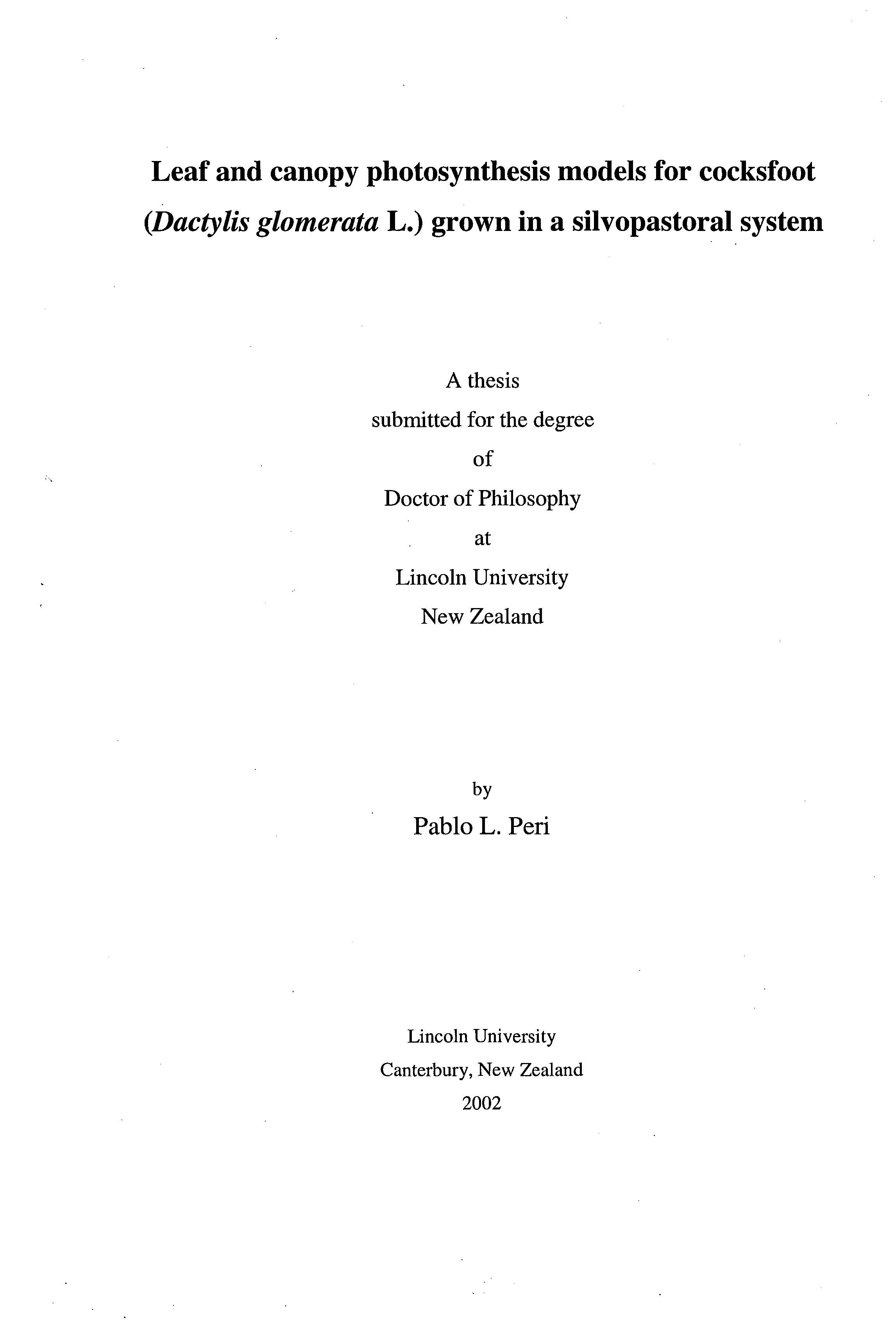Ver ítem
- xmlui.general.dspace_homeCentros Regionales y EEAsCentro Regional Patagonia SurEEA Santa CruzTesisxmlui.ArtifactBrowser.ItemViewer.trail
Leaf and canopy photosynthesis models for cocksfoot (Dactylis glomerata L.) grown in a silvopastoral system
Resumen
The aim of the research reported in this thesis was to construct leaf and canopy photosynthesis models for understorey cocksfoot pasture grown in a 10-11-year old Pinus radiata silvopastoral system. From these models, dry matter (DM) production was predicted based on a numerical description of the biological mechanisms involved in canopy photosynthesis. To do this, a wide range of environmental and management conditions were created through changes in
[ver mas...]
The aim of the research reported in this thesis was to construct leaf and canopy photosynthesis models for understorey cocksfoot pasture grown in a 10-11-year old Pinus radiata silvopastoral system. From these models, dry matter (DM) production was predicted based on a numerical description of the biological mechanisms involved in canopy photosynthesis. To do this, a wide range of environmental and management conditions were created through changes in light intensity and regime, temperature, soil moisture, nitrogen (N) and regrowth duration. A unique component of a silvopastoral system is the fluctuating light regime experienced by the understorey plants. The daily photosynthetic photon flux density (PPFD) integral was 55-62% of the open, with periods of full sunlight (1700-1900 µmol m⁻² s⁻¹ PPFD at midday) and severe shade (129-130 µmol m⁻² s⁻¹ PPFD) that changed within 45-120 minutes depending on the solar angle elevation. A similar pattern obtained from artificial slatted structures, also provided a bimodal light regime but with lower light intensity. The resulting DM growth rates ranged from 2 to 154 kg DM/ha/d. These differences were related to differences in canopy leaf area index (LAI) from 0.5 to 8.2 units caused by a reduced tiller population, canopy etiolation and canopy leaf angle. Net photosynthesis rate from seven light intensities (0, 100, 250, 500, 750, 1000 and 2000 µmol m⁻² s⁻¹ PPFD) were measured in the field using an open infrared gas analysis system. These were used to construct light curves for the youngest fully expanded intact leaves. The prediction of DM production was based on an integrated leaf photosynthesis model that uses a non-rectangular hyperbola function to estimate the saturated leaf photosynthetic rate (Pmax), the photosynthetic efficiency (α) and the degree of curvature (θ) in the photosynthetic response of individual leaves. The highest Pmax was 27.4 µmol CO2 m⁻² s⁻¹ in non-limited conditions. This decreased to a minimum of -0.5 µmol CO₂m⁻² s⁻¹ under severe water stress (Ψlp= -16 bar). Values of α ranged from 0.036 µmol CO₂/µmol PPFD in non-limiting conditions to 0.020 µmol CO₂/µmol PPFD at 1.5% N. The degree of curvature of the leaf response curve θ was unaffected by the range of environmental factors and regrowth duration and had a mean value of 0.96 ±0.02. The response of these parameters to different temperature, N, moisture, regrowth and shade conditions were predicted using a multiplicative model for predicting Pmax, a 'law of the minimum factor' model for α and a constant for θ. These parameters were then incorporated into a canopy photosynthesis model with coefficients for respiration, partitioning and the main canopy characteristics that affect light interception (LAI and leaf angle). Based on this model, cocksfoot DM production was predicted for silvopastoral systems in non-limiting situations and where a single, two, three, four or all five factors were limiting for: air temperatures from 2 to 37 °C, water status from Ψlp -0.1 to -16.0 bar (corresponding to a soil volumetric water content to 500 mm depth of 8.5 to 34%), foliage N content from 1.5 to 5.9%, regrowth duration from 20 to 60 days, and time course of shade (severe shade: 5% of open PPFD or moderate shade: 50% of open PPFD) from 1 to 180 minutes and the correspondent induction process (lag in the rise of photosynthesis rate to the maximum value) from 30, 60 and 180 minutes of severe shade. Using this model, it was shown that the continuous light regime of 50% transmissivity throughout a day had higher canopy photosynthesis than for the same intensity but a fluctuating light regime with periods of 90-120 minutes of full sunlight and severe shade (10.4 vs 8.4 g CO₂ m⁻² d⁻¹). This was due to (i) a faster decrease in Pmax and α for plants experiencing 5% of open PPFD compared with 50% of open PPFD; (ii) the lack of an induction process under continuous shade. These results indicate that artificial shade cloth gives a biased representation of the response of understorey pastures in silvopastoral systems. Validations from observed DM production data (from 9 to 134 kg DM/ha/d) were obtained from different environmental and management conditions and indicated that approximately 86% of the variation in cocksfoot growth rate was accounted for by using the model proposed. Therefore, the canopy photosynthesis model proposed in this study provides a powerful and useful tool for understanding and predicting DM production of cocksfoot understorey pastures in silvopastoral systems.
[Cerrar]

Autor
Director de Tesis
Moot, Derrick J. (supervisor);
Descripción
Tesis para obtener el grado de Doctor of Philosophy (PhD) en Agricultural Sciences, de Lincoln University (New Zealand), en 2002
Fecha
2002
Editorial
Lincoln University, Nueva Zelanda
Formato
pdf
Tipo de documento
tesis doctoral
Palabras Claves
Derechos de acceso
Abierto
 Excepto donde se diga explicitamente, este item se publica bajo la siguiente descripción: Creative Commons Attribution-NonCommercial-ShareAlike 2.5 Unported (CC BY-NC-SA 2.5)
Excepto donde se diga explicitamente, este item se publica bajo la siguiente descripción: Creative Commons Attribution-NonCommercial-ShareAlike 2.5 Unported (CC BY-NC-SA 2.5)


